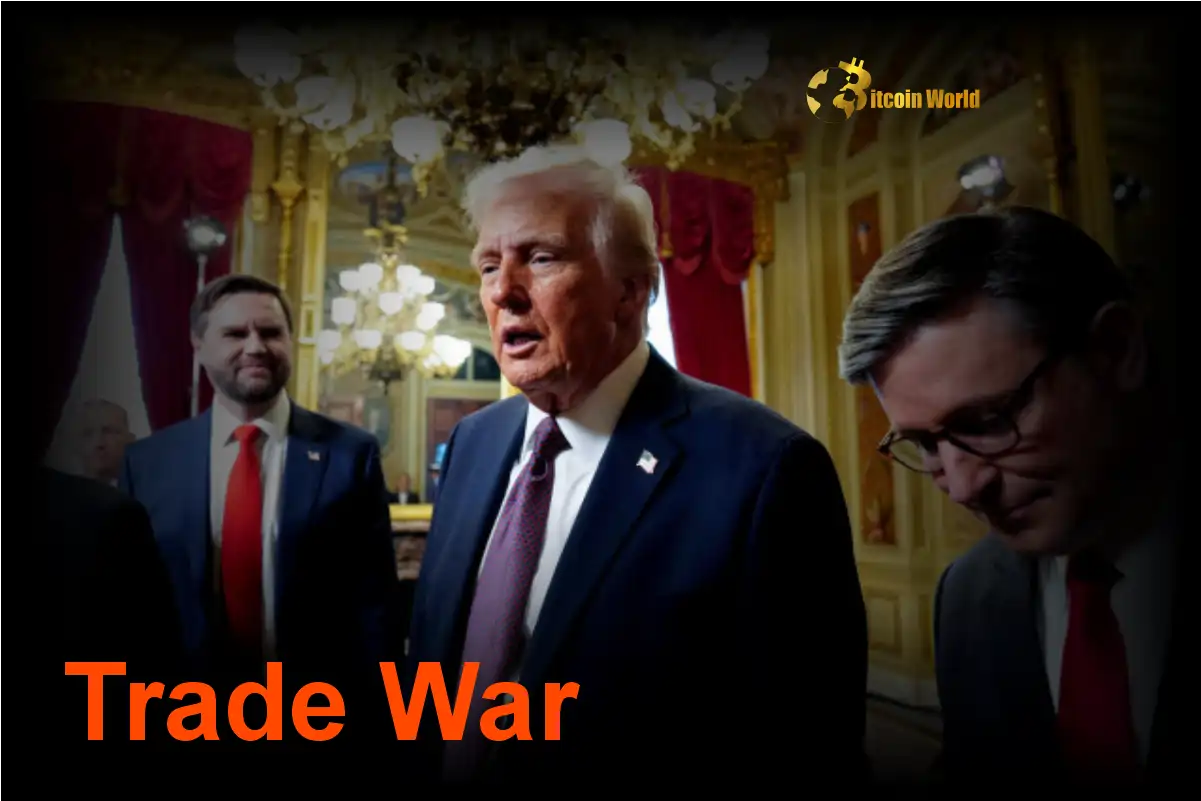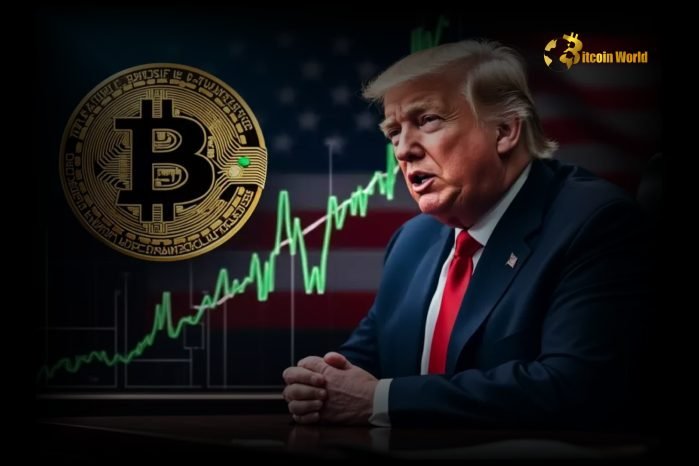Buckle up, crypto enthusiasts! The winds of economic uncertainty are picking up speed, and this time, it’s not just about market corrections or regulatory crackdowns. Whispers from Washington suggest a policy shift that could send shockwaves across global markets, potentially impacting everything from your favorite altcoins to the broader financial landscape. We’re talking about global tariffs – and not just a little tweak, but a potentially massive 20% import tax proposed by advisors to the Trump administration. Let’s dive deep into what this could mean for the world and, more importantly, for your crypto portfolio.
What Exactly Are Global Tariffs and Why Should Crypto Holders Care?
In simple terms, global tariffs are taxes imposed on goods imported from other countries. Think of it as a surcharge added to the price of everything from smartphones to steel, making imported products more expensive. While tariffs are sometimes used strategically, the scale being discussed here – a blanket 20% on goods from almost all nations – is unprecedented in recent history.
Why should you, as someone invested in cryptocurrencies, be concerned? Because international trade and the global economy are intricately linked. A significant disruption in trade flows, like that potentially triggered by widespread tariffs, can have cascading effects:
- Market Volatility: Uncertainty breeds volatility. Stock markets could react negatively, and as we’ve seen, traditional market jitters often spill over into the crypto space.
- Inflationary Pressures: Higher import costs can translate to increased prices for consumers, leading to inflation. While some see Bitcoin as an inflation hedge, the immediate impact of broad inflation can be complex.
- Economic Slowdown: A trade war sparked by these tariffs could stifle global economic growth, impacting investment sentiment across all asset classes, including crypto.
- Geopolitical Instability: Retaliatory tariffs from other nations are highly likely, escalating trade tensions and potentially leading to broader geopolitical instability, which can further fuel market uncertainty.
In essence, while cryptocurrencies operate on a decentralized, global stage, they are not immune to the ripples caused by macroeconomic shifts and policy decisions in major economies like the United States.
The Trump Administration’s 20% Import Tax: A Closer Look
According to reports citing the Wall Street Journal, advisors within the Trump administration are seriously considering imposing an import tax of up to 20% on goods from nearly every country. This isn’t a targeted tariff on specific goods or nations; it’s a broad-stroke approach that aims to reshape global trade dynamics.
Here’s a breakdown of what we know:
- Scope: Potentially applies to goods from almost all nations, excluding perhaps a very select few.
- Magnitude: Up to 20%, a significant increase compared to typical tariffs.
- Rationale (Speculated): Likely aimed at boosting domestic manufacturing, reducing trade deficits, and potentially as a tool for political leverage in international negotiations.
- Retaliation Risk: The proposal explicitly mentions considering “retaliatory tariffs,” suggesting an awareness that other countries will likely respond in kind.
This proposal is still in the consideration phase, but the fact that it’s being discussed at high levels within the administration is enough to raise eyebrows and trigger market speculation. The sheer scale of a 20% import tax is what makes this particularly noteworthy and potentially disruptive.
Potential Benefits and the “America First” Argument
Proponents of such tariffs, often aligned with an “America First” approach, argue that they can bring several benefits:
- Boosting Domestic Industries: By making imports more expensive, domestically produced goods become more competitive, potentially leading to a resurgence in American manufacturing.
- Reducing Trade Deficits: Tariffs could decrease imports, theoretically narrowing the trade deficit.
- Increased Government Revenue: Tariff revenue could provide the government with additional funds.
However, these perceived benefits often come with significant drawbacks, and the economic consensus leans heavily against broad-based tariffs as an effective long-term strategy.
Challenges and the Looming Threat of a Trade War
The potential downsides of implementing Trump tariffs of this magnitude are considerable:
| Challenge | Impact |
|---|---|
| Increased Consumer Prices | Tariffs are ultimately paid by consumers through higher prices for goods and services. This can erode purchasing power and lead to inflation. |
| Retaliatory Tariffs and Trade Wars | Other countries are highly likely to retaliate with their own tariffs on US exports, leading to a trade war where everyone loses. This can severely disrupt global supply chains and economic growth. |
| Damage to International Relations | Unilateral tariffs can strain diplomatic relationships and undermine international trade agreements. |
| Negative Impact on Export-Oriented Industries | Retaliatory tariffs will hurt US export industries, offsetting any potential gains for domestic manufacturers focused on the local market. |
| Supply Chain Disruptions | Global supply chains are complex and interconnected. Tariffs can disrupt these chains, leading to inefficiencies and higher costs for businesses. |
The prospect of a full-blown trade war is a significant concern. History is replete with examples of trade wars leading to economic downturns and heightened international tensions. The Smoot-Hawley Tariff Act in the 1930s, for instance, is widely blamed for exacerbating the Great Depression.
Examples from History: Learning from Past Tariff Policies
Looking back at historical examples of tariffs can provide valuable context:
- The Smoot-Hawley Tariff Act (1930): As mentioned, this US tariff hike is widely considered a major policy blunder that deepened the Great Depression. It triggered retaliatory tariffs and a sharp contraction in global trade.
- Trump Administration Tariffs on Steel and Aluminum (2018): While narrower in scope than the current proposal, these tariffs led to retaliatory measures from trading partners and had mixed economic effects. Some domestic industries benefited, but others faced higher input costs.
- US-China Trade War (2018-2020): This protracted trade dispute involved tariffs on hundreds of billions of dollars worth of goods traded between the US and China. It resulted in economic disruptions for both countries and globally.
These examples highlight the potential for tariffs to backfire and cause unintended negative consequences. A 20% global tariff would be on a scale far exceeding recent examples, making the potential risks even greater.
Actionable Insights: Navigating the Uncertainty in the Crypto Market
So, what can crypto investors do amidst this uncertainty? Here are a few actionable insights:
- Stay Informed: Keep a close watch on news and developments related to trade policy and global economics. Reliable financial news sources and crypto market analysis platforms are crucial.
- Diversify Your Portfolio: Diversification is always a good strategy, especially during times of uncertainty. Consider spreading your investments across different asset classes and cryptocurrencies.
- Risk Management: Reassess your risk tolerance and adjust your portfolio accordingly. Consider using stop-loss orders and other risk management tools to protect your capital.
- Consider Stablecoins: In periods of high volatility, stablecoins pegged to fiat currencies can offer a temporary safe haven within the crypto ecosystem.
- Long-Term Perspective: Remember that market volatility is a normal part of the crypto cycle. Focus on the long-term fundamentals of your chosen projects and avoid making rash decisions based on short-term market fluctuations.
It’s crucial to remember that this is still a developing situation. The proposed global tariffs may not be implemented in their current form, or at all. However, the fact that they are under consideration warrants attention and careful planning.
Conclusion: Bracing for Potential Economic Tremors
The prospect of a 20% global tariff imposed by the Trump administration is a significant development with potentially far-reaching consequences for the global economy and, by extension, the cryptocurrency market. While the stated aims might be to bolster domestic industries and reduce trade deficits, the risks of triggering a global trade war, increasing inflation, and disrupting supply chains are substantial. For crypto investors, navigating this uncertainty requires vigilance, diversification, and a focus on risk management. The coming weeks and months will be crucial in determining the future trajectory of global trade policy and its impact on the digital asset landscape. Stay informed, stay prepared, and remember that in the world of crypto, volatility is often accompanied by opportunity.
To learn more about the latest crypto market trends, explore our article on key developments shaping Bitcoin price action.






